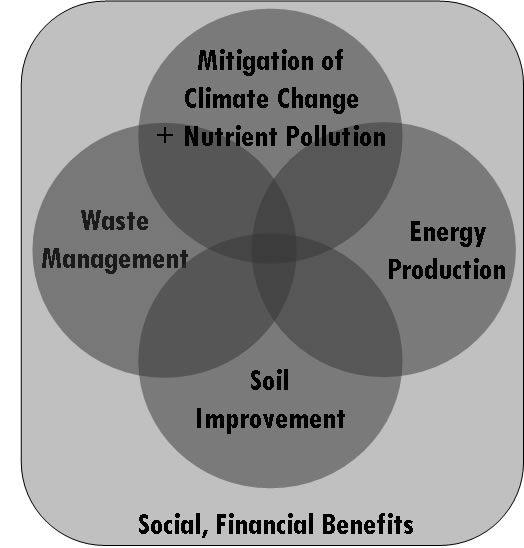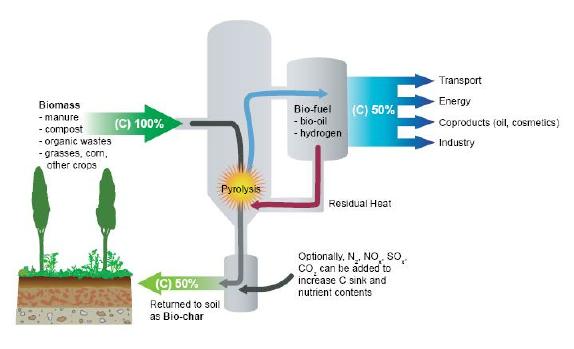 |
Terra Preta de Indio
Biochar Soil Management |
 |
Content: J. Lehmann
Host: Cornell University
Layout: K.Hanley
For optimal viewing:
This website is best viewed in a resolution of 1024 or higher, 32 bit color, and in Mozilla Firefox. Javascript, CSS and Tables.
|
 |
| © All original content belongs to Cornell University. This is a non-profit website for educational purposes that claims no ownership of copyright material. Other images and text belong to their respective owners. No copyright infringment intended. |
| |
| |
| |
|

|
| Basic Concepts | Projects | Work by others | Pictures | References |
| |
| Biochar - The new frontier |
Inspired by the intriguing properties of ancient Terra Preta de Indio, biochar‡ was identified as a soil amendment that has the potential to change concepts of soil management. While "discovered" may not be the right word, as biochar has been used in traditional agricultural practices as well as in modern horticulture, never before has evidence been accumulating that demonstrates so convincingly that biochar has very specific and unique properties that make it stand out among organic soil amendments.
The soil fertility benefits of biochar rest on two pillars:
- The extremely high affinity of nutrients to biochar and other compounds (adsorption)
- The extremely high persistence of biochar (stability)
Beneficial effects of biochar on both soil microbial functions and soil water availability are highly likely but not yet sufficiently quantified to be effectively managed. Biochars are able to correct undesirable pH similar to lime and can therefore be of value to improve acid soils.
These two properties (adsorption and stability) can be used effectively to address some of the most urgent environmental problems of our time:
- Soil degradation
- Water pollution by agro-chemicals
- Climate change
Biochar is not a silver bullet that will solve environmental problems without a much wider and far reaching strategy. But it can provide an important tool to addressing a wide range of the major challenges: soil degradationand food insecurity, climate change, sustainable energy generation and waste management (Figure 1).
|

Figure 1: Biochar system components (Lehmann and Joseph, 2009). |
Reading:
Lehmann J 2007 Bio-energy in the black. Frontiers in Ecology and the Environment 5, 381-387.
Lehmann J and Joseph S 2009 Biochar for Environmental Management: Science and Technology. Earthscan, London. |
|
The two pillars of biochar properties |
Nutrient Affinity
All organic matter added to soil significantly improves various soil functions, not the least the retention of several nutrients that are essential to plant growth. What is special about biochar is that it is much more effective in retaining most nutrients and keeping them available to plants than other organic matter such as for example leaf litter, compost or manures. Interestingly, this is also true for phosphorus which is not at all retained by 'normal' soil organic matter (Lehmann, 2007). |
Reading:
Lehmann J 2007 Bio-energy in the black. Frontiers in Ecology and the Environment 5, 381-387.
Lehmann, J., da Silva Jr., J.P., Steiner, C., Nehls, T., Zech, W. and Glaser, B.: 2003a, ‘Nutrient availability and leaching in an archaeological Anthrosol and a Ferralsol of the Central Amazon basin: fertilizer, manure and charcoal amendments', Plant and Soil 249 , 343-357.
Liang, B. , Lehmann, J., Solomon, D., Kinyangi, J., Grossman, J., O'Neill, B., Skjemstad, J.O., Thies, J., Luizão, F.J., Petersen, J. and Neves, E.G.: 2006, 'Black carbon increases cation exchange capacity in soils', Soil Science Society of America Journal 70: 1719-1730.
Mikan, C.J. and Abrams, M.D.: 1995, 'Altered forest composition and soil properties of historic charcoal hearths in southeastern Pennsylvania', Canadian Journal of Forestry Research 25, 687-696.
Sombroek, W., Nachtergaele, F.O. and Hebel, A.: 1993, ‘Amounts, dynamics and sequestering of carbon in tropical and subtropical soils', Ambio 22, 417-426. |
Persistence
It is undisputed that biochar is much more persistent in soil than any other form of organic matter that is commonly applied to soil. Therefore, associated benefits with respect to nutrient retention and soil fertility are longer lasting than with alternative management. The long persistence of biochar in soil also makes it a prime candidate for the mitigation of climate change as a potential sink for atmospheric carbon dioxide. The success of effective reduction of greenhouse gases depends on the associated net emission reductions through biochar sequestration. A net emission reduction can only be achieved in conjunction with sustainable management of biomass production. During the conversion of biomass to biochar about 50% of the original carbon is retained in the biochar, which offers a significant opportunity for creating such a carbon sink (Lehmann, 2007). This promises biochar to become an appropriate tool to contribute a significant wedge in a wider strategy for the mitigation of the anthropogenic greenhouse effect. |
Reading:
Baldock JA and Smernik RJ. 2002, 'Chemical composition and bioavailability of thermally altered Pinus resinosa (Red pine) wood', Organic Geochemistry 33: 1093-109.
Cheng CH, Lehmann J, Thies JE and Burton S 2008 Stability of black carbon in soils across a climatic gradient. Journal of Geophysical Research (Biogeosciences) 113, G02027.
Kuzyakov, Y., Subbotina, I., Chen, H., Bogomolova, I., Xu, X. 2009. Black carbon decomposition and incorporation into microbial biomass estimated by 14C labeling. Soil Biology and Biochemistry 41, 210-219.
Lehmann, J.: 2007, 'A handful of carbon', Nature 447, 143-144.
Lehmann, .J, Gaunt, J. and Rondon, M.: 2006, 'Bio-char sequestration in terrestrial ecosystems – a review', Mitigation and Adaptation Strategies for Global Change 11, 403-427.
Zimmerman, A. 2010. Abiotic and microbial oxidation of laboratory-produced black carbon (biochar). Environmental Science and Technology44, 1295–1301.
|
|
Landuse systems and biochar use |
Biochar research and development has experienced a meeting of interests by different scientific communities and stakeholders that allow an exciting perspective on how to handle biomass in a future economy. The potential to combine bio-energy production, sustainable agriculture and waste management while reducing greenhouse gas emissions into one approach using biochar offers in many cases significant synergism for a combined strategy (see Figure 2). |

Figure 2: Biochar system from input of residues or purpose-grown biomass to biochar production, generation of bio-energy and sequestration of approximately 50% of the carbon from the biomass in soil (Lehmann 2007).
|
Bio-Energy and Biochar |
During biochar production, liquids and gases are generated that can be used as energy or bioproducts (food flavoring etc). The range of possible energy carriers range from heat to electricity, green hydrogen, methane, bio-oils or other liquid and gaseous fuels.Several different technologies exist (slow pyrolysis, fast pyrolysis, flash pyrolysis, gasification, torrefaction) that all have strengths in generating one product range more efficiently than others. The choice of technology will depend on the local situation.
The co-production of biochar and its application to soil ensures that soil fertility is not depleted (by esnuring a minimum ground cover) in comparison to situations where biomass is taken from agricultural land and no organic matter is returned.
The biomass to produce bioenergy through pyrolysis is very wide and can include wood chips or pellets, bark and sawdust, crop residues such as nut shells or rice husks, dry animal manure, green municipal waste and grass residues such as bagasse from the sugarcane industry or corn stalks.
|
Reading:
Day, D., Evans, R.J., Lee, J.W. and Reicosky, D.: 2005, 'Economical CO2, SOx, and NOx capture from fossil-fuel utilization with combined renewable hydrogen production and large-scale carbon sequestration', Energy 30, 2558-2579.
Lehmann J.: 2007, 'Bioenergy in the black'. Frontiers in Ecology and the Environment 5, 381-387.
Lehmann, .J, Gaunt, J. and Rondon, M.: 2006, 'Bio-char sequestration in terrestrial ecosystems – a review', Mitigation and Adaptation Strategies for Global Change 11, 403-427.
Li, X., Hagaman, E., Tsouris, C. and Lee, J.W.: 2003, 'Removal of carbon dioxide from flue gas by ammonia carbonization in the gas phase', Energy & Fuels 17, 69-74.
Yaman, S.: 2004, 'Pyrolysis of biomass to produce fuels and chemical feedstocks', Energy Conversion and Management 45, 651-671.
Marris, E.: 2006, 'Black is the new green', Nature 442: 624-626.
Lehmann, J.: 2007, 'A handful of carbon', Nature 447, 143-144. |
|
Sustainable Agriculture |
In both industrialized and developing countries, in mechanized and large-scale or subsistence agriculture, lack of carbon is constraining ecosystem health. Biochar may in many cases be an appropriate approach to make this valuable commodity last longer, be more efficient in soil, and in combination with energy production, carve out carbon that would otherwise be wasted and even harmful to environment and human health. Intelligent solutions tailored to local opportunities and constraints are required. |
|
Waste Management |
Animal manure, agricultural residues or municipal yard wastes can be a significant burden on the environment. Nutrients contained in manures may cause eutrophication of surface waters or pollution of ground waters. Landfills of municipal green wastes may generate large quantities of greenhouse gases. But all these substances can be useful when managed properly. Biochar production is an intelligent way of recycling organics and reduce environmental pollution. |
Reading:
Laird D 2008 The charcoal vision: A win–win–win scenario for simultaneously producing bioenergy, permanently sequestering carbon, while improving soil and water quality. Agronomy Journal 100, 178-181.
Lehmann, J.: 2007, 'A handful of carbon',Nature 447, 143-144.
Lehmann J 2007 Bio-energy in the black. Frontiers in Ecology and the Environment 5, 381-387.
Lehmann J and Joseph S 2009 Biochar for Environmental Management: Science and Technology. Earthscan, London.
Mathews JA 2008 Carbon-negative biofuels. Energy Policy 36, 940-945. |
|
‡ also spelled bio-char; some literature (especially before 2006) uses the term charcoal or the more generic term biomass-derived black carbon; in the context of agricultural application sometimes called agrichar or agri-char, which we do not adopt due to the wider applicability of biochar for environmental management beyond agriculture. |
|
|



